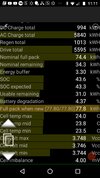Hello everybody,
I´m new here and 3 month ago a bought a 2016 model S 90D.
I wanted to share some info about my car that seems to be a bit unusual.
The car has been a taxi in Stockholm, Sweden between December 2016 and December 2020.
I bought it in February 2021 from a regular car dealership. I had been looking for over a year and since there are so few Teslas in Sweden,
I assumed that I had to look around in Europe to find the right car, but the health situation has made it impossible.
When this car was turned up for sale, I saw that it was of low interest due to its background. The car salesman did not know anything at all about the car, so I bought it at a very good price. It is equipped with AP1, free supercharging, premium audio and premium connectivity.
The screenshot is from Scan my Tesla and there are some numbers that sticks out:

Nominal remaining 73.8 kWh out of nominal full pack 73.8 kWh
Supercharging 89989 kWh out of total charge 124137 kWh
The car has been supercharged 72% of its 1682 charge cycles.
I have been confirmed from Tesla support that the battery has not been changed and the sticker shows its the original battery that came with the car.

I have started a YouTube channel to show people how old tesla age and what the quality of Teslas is and how they hold up after many miles.
Please have a look and support my new channel by subscribing to it.
Sorry for my long first post
I´m new here and 3 month ago a bought a 2016 model S 90D.
I wanted to share some info about my car that seems to be a bit unusual.
The car has been a taxi in Stockholm, Sweden between December 2016 and December 2020.
I bought it in February 2021 from a regular car dealership. I had been looking for over a year and since there are so few Teslas in Sweden,
I assumed that I had to look around in Europe to find the right car, but the health situation has made it impossible.
When this car was turned up for sale, I saw that it was of low interest due to its background. The car salesman did not know anything at all about the car, so I bought it at a very good price. It is equipped with AP1, free supercharging, premium audio and premium connectivity.
The screenshot is from Scan my Tesla and there are some numbers that sticks out:
Nominal remaining 73.8 kWh out of nominal full pack 73.8 kWh
Supercharging 89989 kWh out of total charge 124137 kWh
The car has been supercharged 72% of its 1682 charge cycles.
I have been confirmed from Tesla support that the battery has not been changed and the sticker shows its the original battery that came with the car.
I have started a YouTube channel to show people how old tesla age and what the quality of Teslas is and how they hold up after many miles.
Please have a look and support my new channel by subscribing to it.
Sorry for my long first post



